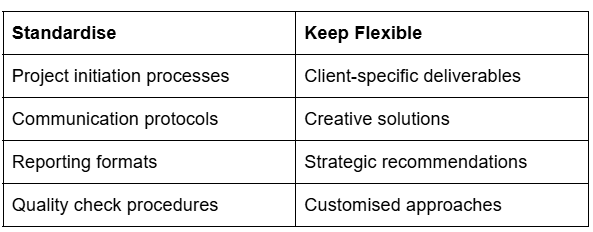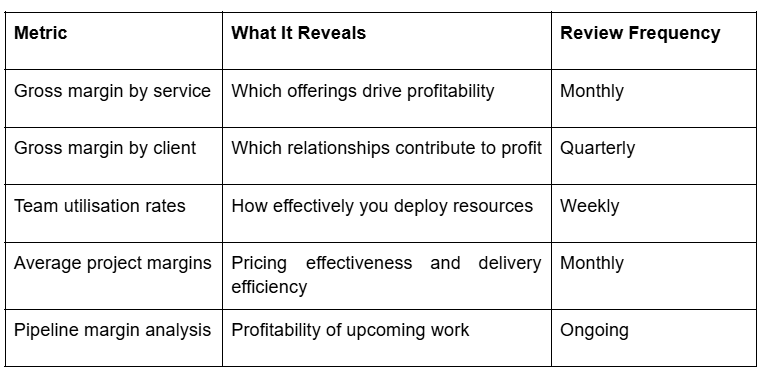Agency Profit Margins 2026: How to Optimise Service Pricing and Reduce Costs

Revenue growth looks impressive on paper, but profit margin tells the real story of agency health. Too many agencies chase turnover whilst watching margins erode, discovering too late that growth without profitability is just expensive noise.
The difference between a struggling agency and a thriving one often comes down to margin management. No need for dramatic changes or revolutionary strategies. All you need is a systematic optimisation of what you sell, how you price it, and what it costs to deliver.
Why Margins Matter More Than Revenue
Consider this comparison:

Agency B works twice as hard for less profit. They have more staff to manage, more overheads to cover, more complexity to navigate.
Margin expansion creates breathing room for investment, provides resilience during downturns, and builds enterprise value far beyond what revenue growth alone achieves. Buyers value profit, not turnover. So do banks when you need financing.
Yet most agencies obsess over revenue targets whilst treating margin as an afterthought. They land new clients without questioning profitability, add services because clients ask, and grow teams without analysing contribution. The result? Busy agencies that struggle to generate sustainable profit.
Get To Know Your Service Mix
Not all agency services are created equal when it comes to profitability. Some services consistently deliver healthy margins whilst others consume resources without generating proportional returns.
The Four-Quadrant Framework
Categorise your services based on both margin and revenue contribution:
High Margin, High Revenue: These represent your core business—the offerings you should be selling more of and protecting fiercely. They combine strong pricing power with efficient delivery models.
High Margin, Low Revenue: These indicate untapped potential. You've proven the profitability model but haven't scaled the opportunity. They deserve investment in marketing and business development.
Low Margin, High Revenue: This is the most dangerous trap. Services look successful because they generate significant turnover, but they consume disproportionate resources. Many agencies discover their largest services are their least profitable.
Low Margin, Low Revenue: Question these ruthlessly. Unless they serve strategic purposes—market entry, relationship building, or lead generation for more profitable work—they're destroying value.
What Possibly Kills Your Profits?
Certain service characteristics consistently predict margin problems:
- Scope creep vulnerabilities – Services with unclear deliverables or success metrics where client expectations expand whilst pricing remains fixed
- High touch requirements – Excessive client meetings, reporting, or customisation that drains resources
- Resource intensity mismatches – Services requiring specialist skills or senior time but priced as commodity offerings
- Technology dependencies – Reliance on expensive third-party platforms or constant tool switching that reduces efficiency
Pricing Strategies That Protect Margins
Pricing represents the fastest path to margin improvement—small changes create immediate impact without requiring operational overhaul.
Moving Beyond Cost-Plus Thinking
Cost-plus pricing (calculating your costs and adding a markup) anchors you to expenses rather than value. It penalises efficiency (get faster, earn less) and ignores what clients will actually pay.
Value-based pricing flips this equation. You price based on the value delivered to clients rather than your internal costs. This requires understanding client economics, identifying tangible outcomes, and articulating value in their terms.
For a lead generation campaign, cost-plus pricing might yield £5,000 based on hours invested. Value-based pricing for the same campaign could justify £15,000 if it generates £500,000 in qualified pipeline for the client. Same work, triple the margin, because the pricing reflects outcome rather than input.
Retainer vs Project: The Strategic Balance

The optimal approach combines both models strategically:
Use retainers for ongoing services with predictable resource requirements and clear boundaries. Price them generously to accommodate natural scope expansion whilst protecting margins.
Reserve project pricing for defined deliverables where you can control scope and demonstrate clear value. This allows premium pricing for discrete outcomes.
Consider hybrid models where retainers cover baseline services whilst projects address specific initiatives. This provides revenue stability whilst creating opportunities for margin expansion.
How you present pricing affects client acceptance and your ability to protect margins.
- Anchor high by presenting the full-scope option first
- Package strategically with good-better-best options where your preferred solution sits in the middle
- Separate price from scope in initial conversations—establish value first
- Defend increases confidently by articulating value delivered and resource investment required
Optimise Your Cost Structure
Pricing improvements mean nothing if your cost base consumes the gains. Sustainable margin expansion requires systematic cost management without sacrificing quality or capability.
Manage Team Costs Effectively
Staff costs typically represent 50-70% of agency expenses, making team structure the primary margin lever.
Utilisation Rates: Most agencies track this poorly or not at all. Improving utilisation from 60% to 70% effectively increases your team's capacity by 17% without adding headcount.
Seniority Mix: Overusing senior staff on junior tasks destroys profitability. Underusing junior staff on appropriate work creates quality issues. The optimal mix depends on your services and pricing, but most agencies skew too senior.
Freelancer Strategy: Heavy freelancer reliance increases flexibility but often costs more per hour whilst reducing quality control. Finding the right balance requires analysing which capabilities you need consistently versus occasionally.
Leverage Models: How much junior capacity supports each senior resource? Management consultancies often operate at 5:1 or higher ratios, whilst creative agencies may function at 2:1. Your optimal leverage depends on service complexity and client interaction requirements.
Control Overhead Creep
Non-staff costs creep upwards without active management:
- Technology sprawl – Overlapping subscriptions and unused tools that compound annually
- Office costs – Traditional space requirements that may no longer align with remote working realities
- Marketing spend – Activities that continue through inertia rather than results
- Administrative inefficiency – Processes that made sense at smaller scale but now kill margins
Regular audits identify redundancy and optimisation opportunities across all overhead categories.
Improve Service Delivery Efficiency
How efficiently you deliver services directly impacts margin regardless of pricing or cost structure.
The key here is standardisation without commoditisation.
Creating repeatable processes improves delivery efficiency whilst reducing errors and training time. However, excessive standardisation can commoditise your offerings and reduce pricing power.
The balance lies in standardising foundational elements whilst maintaining flexibility in client-facing deliverables:

Furthermore, process documentation captures institutional knowledge and enables consistent delivery across team members. This reduces dependency on specific individuals and supports scaling. Also, template libraries accelerate delivery for common requirements—strategy frameworks, presentation formats, reporting structures, client communication templates. Quality gates prevent costly rework by catching issues early through defined review points, approval workflows, and success criteria.
Leverage Technology
Strategic technology deployment multiplies team capability without proportional cost increases.
Automation Opportunities
- Reporting generation
- Data analysis
- Content distribution
- Performance monitoring
Consider what can be integrated with AI. From content generation to research synthesis to initial design concepts, AI tools extend what your team can deliver within existing time constraints. Then, explore workflow tools to manage processes. When teams spend less time managing work and more time doing work, utilisation and margins improve.
Measure Your KPIs
Optimisation requires measurement. Without clear visibility into margin performance, you're guessing rather than managing.
Essential Metrics to Track

Turn Data Into Action
Metrics only create value when they drive decisions:
When gross margin falls below targets, investigate whether pricing, costs, or delivery efficiency is the primary driver. Each requires different interventions. When specific clients or services consistently underperform, decide whether to restructure the relationship, reprice the work, or exit the engagement. When utilisation drops, identify whether it's a capacity planning issue, a business development problem, or a resource allocation challenge.
The agencies that thrive over the long term treat margin optimisation as an ongoing discipline rather than a one-time project. They build systems for visibility, create processes for improvement, and maintain focus on profitability alongside growth.
Ready to optimise your agency's margins systematically?
Our team specialises in financial management for service-based agencies and can help you analyse your service mix, refine pricing strategies, and improve cost efficiency.
Book a consultation to discuss how we can help you build a more profitable agency without sacrificing growth.


.jpg)

